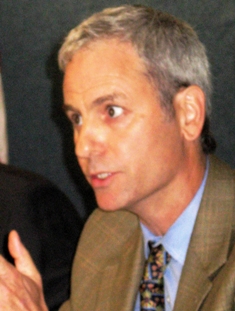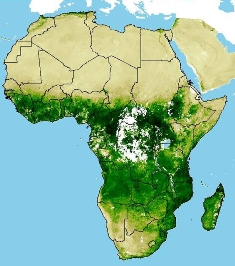Climate change and global health go hand in hand
May - June, 2008 | Volume 7, Issue 3
Marriage between climatology and biology has the potential to improve global health by predicting disease outbreaks and lessening the effects of pollution-driven chronic illness, say researchers advocating a systems approach to global warming preparedness.

Fogarty's Joshua Rosenthal
explains the link between climate change and public
health at a National Press Club forum.
Characterizing the model for collaboration as a microscope linked to a satellite, National Oceanic and Atmospheric Administrator Conrad C. Lautenbacher said, "Everything is connected in our earth system... It's science without borders" and requires integration of data from basic researchers, health providers, weather forecasters and environmentalists looking at the very long term effects of human-caused climate change.
"The health community - NIH and CDC - already are engaged in a substantial amount of research and training that aids preparedness for climate change," Dr. Joshua Rosenthal, deputy director of Fogarty's international training and research division and director of its environment programs, told the forum on "Changing Climate: Changing Health Patterns."
"The overarching goal is to think about strengthening basic health research, surveillance and reporting, with an eye on the most vulnerable populations," Rosenthal said. That eye is often a space satellite measuring ocean temperature, vegetation and weather patterns like El Nino/La Nina - collecting data that in the hands of public health experts could be tailored to preventing disease, or at least treating it faster.
Lautenbacher said, for example, when satellites measure the temperature of water in the Bay or Bengal, the data track with later outbreaks of cholera in the region.
Predicting the arrival of flooding should be more than just protecting property, Rosenthal said. It should also warn people in developing nations about the potential spread of diseases such as schistosomiasis (snail fever) and other hazards such as toxic pollutants.

Photo courtesy of NOAA
Satellite images such as this one, captured last month in Africa, show where vegetation density is higher. In these areas, the risk of malaria may also be higher. Where areas are brown, the risk is lower.
One example of a current Fogarty-sponsored study is how parasitic diseases in Kenya change during the transition from drought conditions to flooding, Rosenthal explained. Another area of analysis for the NIH, he said, is natural disaster and the community reaction to it, such as studying post-traumatic stress syndrome and drug abuse in survivors of Hurricane Katrina or our ability to contain the spread of health effects of hazardous materials after a major fire.
Panelists also stressed the importance of systems thinking that includes agriculture and urbanization patterns, energy, economics and health care.
"It's important...that we build climate into these other types of long-term analyses rather than trying to separate it out," Rosenthal said.
When there is a natural disaster or outbreak of disease, "What we do know is it's probably going to hit the most vulnerable populations the hardest: the poor, children, the elderly, those in low- and middle-income countries with weak infrastructure, degraded ecological environments, poor health-delivery systems," he said.
"Sound science needs to drive sound policy," Lautenbacher said, calling for the study of climate change "in a more rational and less emotional fashion for decision makers and for the people."
The forum was sponsored by the World Federation of Public Health Associations, the American Public Health Association and the U.S. Group on Earth Observations and held at the National Press Club in Washington.
To view Adobe PDF files,
download current, free accessible plug-ins from Adobe's website.